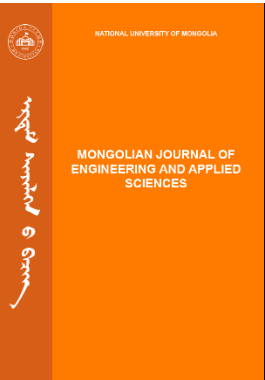ХИЙМЭЛ ДАГУУЛЫН МЭДЭЭЛЭЛ АШИГЛАН МАШИН СУРГАЛТЫН АРГААР ОЙН ТҮЙМРИЙН ЭРСДЭЛИЙГ УРЬДЧИЛАН ТААМАГЛАХ НЬ
FOREST FIRE RISK PREDICTION USING MACHINE LEARNING METHODS USING ARTIFICIAL SATELLITE DATA
Keywords:
машин сургалтын арга, ойн түймрийн эрсдэл, MODISAbstract
Монгол орны уур амьсгалын гол онцлог бол жилийн дөрвөн улирлын ялгаа ихтэй, энэ чанараараа агаарын температурын хэлбэлзэл өндөр, хур тунадас бага, уур амьсгалд өргөрөгийн болон өндрийн бүслүүрийн ялгаа тодорхой илэрдэг явдал юм. Монгол улсад ой хээрийн түймрийн хяналт, шинжилгээний судалгааны арга зүй хязгаарлагдмал байдаг. Хээрийн түймэр нь голдуу хавар, намрын улиралд хур тунадас багатай, хуурай, аянга, цахилгаан, хэт халалт зэрэг байгалийн хүчин зүйлс болон хүний буруутай үйл ажиллагаанаас үүдэн гардаг. Энэхүү судалгааны зорилго нь хээрийн түймрийг машин сургалтын арга Random Forest (RF) ангиллын аргыг ашиглан ой хээрийн түймэрт дүн шинжилгээ хийхэд чиглэгдсэн. Судалгааны мужаар Монгол орны зүүн хэсэгт орших Дорнод аймгийн хойт хэсэг Сибирийн ойн бүсийн үргэлжлэл бүс нутгийг сонгож авсан бөгөөд тус аймагт жил бүрийн хаврын улиралд ой, хээрийн түймрийн тохиолдол ихээхэн гардаг. Иймээс судалгаанд 2015-2022 оны хаврын улирлыг сонгон авсан. Судалгааны ажлын хүрээнд MODIS хиймэл дагуулын мэдээллийг ашиглан хөрснөөс хамаарсан ургамлын индекс (MSAVI), нормчлогдсон шаталтын харьцааг (NBR) зэрэг индексийг тооцож гарган түймрийн бодит тохиолдлуудтай харьцуулсан. Түүнчлэн агаарын температур, хур тунадас, салхины хурд болон MSAVI, ургамлын нормчлогдсон индекс (NDVI), газрын гадаргын температур (LST), өндрийн тоон загвар (DEM) зэрэг хүчин зүйлсээс хамааруулан хээрийн түймрийг RF ангиллын аргаар таамаглах аргачлалыг дэвшүүлсэн. Ой хээрийн түймрийн зураглалын загварын үр дүнг газрын бодит мэдээлэлтэй харьцуулж, ойн сангийн эрсдэл, өөрчлөлтийн мэдээлэлтэй харьцуулахад 75% таарсан үзүүлэлтэй бөгөөд түймрийн голомтын 86 хувь нь ойн талбай, 14 хувь нь хээрийн түймэр байна. Судалааны гол зорилгод түймэртэй, түймэргүй гэсэн 2 ангилалд хуваан, машин сургалтын арга ашиглан урьдчилан таамаглсан нь зорьсон үр дүнд хүрсэн.
Downloads
References
Nandin-Erdene Geserbaatar EN, Lkhamjav O. The impact of forest fire on forest cover types in mongolia. The International Archives of the Photogrammetry, Remote Sensing and Spatial Information Sciences. 2020;Vo. XLIII-B3.
Elbegjargal Nasanbat ABCTOAP Ochirkhuyag Lkhamjav, Dorjsuren M. A spatial distribution map of the wildfire risk in mongolia using decision support system. The International Archives of the Photogrammetry, Remote Sensing and Spatial Information Sciences.
;XLII-3/W4.
Veerappampalayam Easwaramoorthy Sathishkumar MS Jaehyuk Cho, Naren OS. Forest fire and smoke detection using deep learning-based learning without forgetting. Fire Ecology. 2023;19(9).
Munkh-Erdene ADJE A, Erdenebaatar N. Forest fire risk assessment model using remote sensing and GIS techniques in Tujiin Nars National Park, Mongolia. Proceedings of the Mongolian Academy of Sciences. 2021, doi: 105564/pmasv61i011557:10-9.
Byambakhuu BVNCea G. A wildfire monitoring study for burn severity and recovery process using remote sensing techniques: A case study near Shiliin Bogd mountain, Eastern Mongolia. Journal of Geographical Issues. 2022, doi:1022353/v22i1;22(1):22-31.
Amarsaikhan BHHGMD, Moon TH. Applications of remote sensing and geographic information systems for urban land-cover change studies in Mongolia. Geocarto International. 2009, doi: 101080/10106040802556173;24:4:257-71.
P C, A M. A Data Mining Approach to Predict Forest Fires using Meteorological Data. In New Trends in Artificial Intelligence, 13th EPIA 2007- Portuguese Conference on Artificial Intelligence. 2007:512—523.
Davies SWMM D K ; Ilavajhala, Justice CO. Fire Information for Resource Management System: Archiving and Distributing MODIS Active Fire Data. IEEE Transactions on Geoscience and Remote Sensing. 2009:72-9.
Z J, L LT. Linking land, air and sea: potential impacts of biomass burning and the resultant haze on marine ecosystems of Southeast Asia. Global Change Biology. 2014:2701-7.
Chisholm R A WLS, T S. The need for long-term remedies for Indonesia’s forest fires. Conservation Biology. 2016:5-6.
Huijnen V KJGDFJPMIAMDMB Wooster M, van Weele M. Fire carbon emissions over maritime southeast Asia in 2015 largest since
Scientific Reports 26886. 2016.
Stockwell C E CM Jayarathne T. Field measurements of trace gases and aerosols emitted by peat fires in Central Kalimantan, Indonesia, during the 2015 El Nino. Atmospheric Chemistry and Physics. 2016:11711-32.
R Dutta AD J Aryal, Kirkpatrick JB. Deep cognitive imaging systems enable estimation of continental-scale fire incidence from climate data. Scientific reports. 2013;3(1):1-4.
Jain P SSGCMTSFMD Coogan S C P. A review of machine learning applications in wildfire science and management. 2020.
Harishchander Anandaram a RFCBKKY Nagalakshmi M b. Forest fire management using machine learning techniques. Measurement: Sensors. February 2023;25.
Erdenetuya M. Fire occurrence and burning biomass statistics in Mongolia. Ambassador City Jomtien Hotel Pattaya. 2012.
Roger D Hungerford WHFKCRGJN Michael G Harrington. Influence of fire on factors that affect site productivity. Symposium
on Management and Productivity of Western- Montane Forest Soils. 1990.
Davaajargal Jargalsaikhan TR Bayanjargal Darkhijav. Estimation of crop suitability using NDVI in the Kherlen Basin
Dornod province, Mongolia. International Journal of Science, Environment and Technology.
;10(1):19-28.
B Norovsuren BTBBAYAT T Renchin. Estimation of forest coverage using sentinel and landsat in northern region of mongolia. The
International Archives of the Photogrammetry, Remote Sensing and Spatial Information Sciences. 2019, doi: 105194/isprs-archives-XLII-5-W3-71-2019.
Jargaldalai Enkhtuya BUMEA Amarsaikhan Damdinsuren. Land cover classification using machine-learning method and vegetation indices. Mongolian Journal of Geography and Geoecology - MJGG. 2022;43.
A R. Artificial intelligence and machine learning applications in forest management and biodiversity conservation. Natural Resources Conservation and Research. 2023;6.
Cutler DR BK Edwards TJ. Random forests for classification in ecology. Ecology. 2007;88(11):2783-92.
Kubosova K JJ Brabec K. Selection of indicative taxa for river habitats: a case study on benthic macroinvertebrates using indicator
species analysis and the random forest methods. Hydrobiologia. 2010;651:101-14.
Oliveira S SMAJ Oehler F. Modeling spatial patterns of fire occurrence in Mediterranean Europe using multiple regression and random forest. Forest Ecol Manage. 2012;275:117-29.
Rodrigues M RJ. An insight into machine-learning algorithms to model human caused wildfire occurrence. Environ Model Softw. 2014;57:192-201.
Kane VR ACC Lutz JA. Water balance and topography predict fire and forest structure patterns. Forest Ecol Manag. 2015, doi: 101023/A:1010933404324;338:1-13.
L B. Random forests. Machine Learning. 2001, doi: 101023/A:1010933404324;45:5-32.
Przyborski P. Normalized Difference Vegetation Index (NDVI). Earth observatory. 2000.
Qi J HARKYHSS Chehbouni A. A modified soil adjusted vegetation index. Remote Sensing of Environment. 1994;48(2):119-26.
Downloads
Published
How to Cite
Issue
Section
License
Copyright (c) 2024 Mongolian Journal of Engineering and Applied Sciences

This work is licensed under a Creative Commons Attribution-NonCommercial-ShareAlike 4.0 International License.






